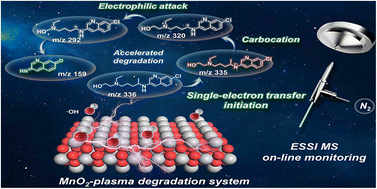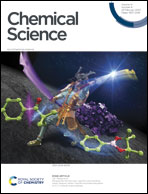OH radical-initiated single-electron transfer for accelerated degradation via carbocation intermediates†
Abstract
Single electron transfer (SET) has made great contributions to a broad range of chemical processes, whose radical cation and carbocation intermediates are important for mechanism studies. Herein, hydroxyl radical (˙OH)-initiated SET was revealed in accelerated degradations, via the online examination of radical cations and carbocations by electrosonic spray ionization mass spectrometry (ESSI-MS). In the green and efficient non-thermal plasma catalysis system (MnO2-plasma), hydroxychloroquine was efficiently degraded upon SET via carbocations. In the plasma field full of active oxygen species, ˙OH was generated on the MnO2 surface to initiate SET-based degradations. Furthermore, theoretical calculations revealed that ˙OH preferred to withdraw the electron from the N atom that was conjugated to the benzene ring. This facilitated the generation of radical cations through SET, which was followed by the sequential formation of two carbocations for accelerated degradations. Transition states and energy barriers were calculated to study the formation of radical cations and subsequent carbocation intermediates. This work demonstrates an ˙OH-initiated SET for accelerated degradation via carbocations, providing a deeper understanding and the potential for the wider application of SET in green degradations.



 Please wait while we load your content...
Please wait while we load your content...